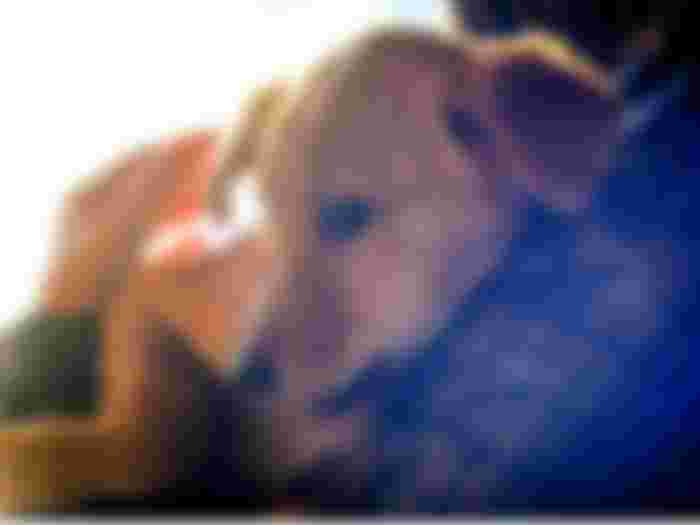Again and again situations arise in which the dog is insecure, reacted fearfully or even panic. Especially in dog care , where the four-legged friend is separated from his caregiver, it is important to give the dog security and to counteract fear.
How do I recognize fear in dogs ? How can I calm my dog down ? I will reveal the 10 calming tips for your four-legged friend.
Recognize fear in dogs and counteract it at an early stage
Fear can occur in dogs while walking or at home in all situations. For the majority of dogs, loud noises, bangs, and droning are very scary, even from a distance . You probably know your dog well and already know when he's scared. If you are looking after a dog that you do not know very well, there are certain situations in which you should watch it closely. You should be particularly careful with young dogs and frightened characters. In order to be able to counteract the fear, you should recognize the preliminary stage: the uncertainty .

The uncertainty shows up differently in dogs. Mostly it manifests itself by a general tension and restlessness combined with panting. The coming fear can also be easily recognized by the posture . The dog lowers its head, crouches, averts its gaze and has a hanging tail. If the fear is already advanced, he pulls in the tail completely.
Act correctly in the fearful situation and calm the dog down
If the dog is already afraid, there are different ways to calm the dog down, depending on the extent of the fear and the situation.
1. Your own behavior
First and foremost, you should keep your dog safe . As with humans, the dog can be calmed down by the mere presence of a caregiver and the fear can be reduced somewhat. Understand your dog and put yourself in his position. The calm and deep voice of the master and a few comforting words often relax the dog . Also pats can on the dog have a calming effect.
Again and again one hears that one should ignore fearful dogs rather than comfort them. The reason for this is that dogs see petting and caring as a reward and are therefore encouraged in their behavior. That could worsen the reaction next time. However, this is not always the right behavior.
How dog owners ultimately deal with anxious dogs also depends a little on their upbringing . It is true that dogs shouldn't be kidnapped every time they shiver. However, dog trainers agree that dogs should not be ignored when they are afraid.

But beware! Depending on the dog's temperament, the dog may feel threatened and even bite if it is too close. Certain dogs react aggressively with increasing uncertainty and fear and need their space and retreat.
2. Make the environment safe
Offer your dog at least one possibility of retreat . No matter whether he likes to crawl under the bed, goes into the basement or gets into his dog crate - let him go where he feels safest and most comfortable.
Also, keep all windows closed and darken them if necessary. Doors must never be open either. Dogs that are fearful and panicked sometimes run away uncontrollably, crawl into hiding and cannot find their way home.
3. Turn on the music
A popular and very effective trick is playing music. First and foremost, it's just about covering up the blasts and distracting the dog. So it doesn't matter what music it is. You can just turn up the radio or play classical music.
There are also certain devices, such as RelaxoPET , which reproduce high-frequency sounds that can only be heard by dogs . This ensures better relaxation and reassurance for the dog. However, it may take a little time to get used to it.
4. Feed the dog
In the early stages of fear, however, food can calm dogs down. By eating dogs are on the one hand occupied and distracted, on the other hand they are also calmed down . The reason for this is the release of happiness hormones during nibbling, licking and chewing , which automatically calms the dog.
Therefore, choose a pig's ear or other treat that the dog is busy with and has to nibble a lot.
You can find delicious and unusual chewing items at AM Hals . In addition to sprats and lung cubes, which are eaten very quickly, there are other treats in the online shop that keep your furry friend busy a little longer. In the picture you can see lamb ears with fur, but also a horse's scalp , ox pizzle and whole deer legs are ideal for distracting and calming your dog. Have a look, your dog will love it!
Targeted feeding for dogs in fearful situations only works sometimes. If the dog has already reached a certain level of stress , it refuses to eat any food.
5. Soothing massage for the dog
Stroking the ears has a particularly good effect due to the many acupuncture points.
Gently stroke the outside of the ear with your thumb, from the auricle to the tip. The other hand remains calmly on the dog.
Place both hands on the dog's back, 2 inches apart . Push both hands together with light pressure, hold them briefly and then slowly return to their starting position. This technique can be used anywhere from the neck to the back to the base of the tail.
Stroking from the nose over the head to the tail is easy and yet calming . Your hand is slightly arched. Make sure you have a loose wrist and conscious breathing.

6. Sedatives
Depending on the level of fear and the duration of the situation, certain sedatives for dogs are effective for restlessness.
Herbal tranquilizers
Herbal tranquilizers have few side effects and are good for calming dogs. As with humans, lavender, hops, valerian, and St. John's wort can be relaxing for dogs. The dosage depends on the dog's size, weight, age and level of calmness.
Even Bach flowers have a calming effect on dogs. Bach flowers are a herbal sedative and belong in every pet pharmacy . They are usually given in the form of drops and are therefore also known as "emergency drops".
Pharmaceutical tranquilizers
Pharmaceutical tranquilizers work very reliably within a few minutes and are usually administered on the advice of a doctor . However, this type of sedative should not always be your first choice and should only be used sparingly. Normally, you only use it in extremely stressful situations . If the stress level is lower, you should first try other methods to calm the dog down.
Unlike herbal sedatives, chemical ones have some side effects . Depending on the drug, these include drowsiness, nervousness or aggressiveness. There is also the risk of overdosing.
7. Use pheromones
Pheromones are ideal for reducing anxiety, especially in dogs that can smell extremely well. There are thousands of pheromones with a wide variety of functions and effects. Among them is Apasine , which is secreted by the mother dog over several weeks and has a calming effect on the puppies.
The animal industry has made use of this and developed the artificial pheromone Adaptil from it , which is supposed to calm the dog. This is contained in certain pheromone atomizers or pheromone
collars. There are even treats made with these calming pheromones.
8. Swiss stone pine pillows
The stone pine is a purely natural product and has many positive properties. In addition to its antibacterial effect and its pleasant scent, it also has a calming effect on humans and animals . WickiundNici sells special stone pine pillows for dogs in different colors and sizes.

The pillows filled with pine chips help your dog to relax and help him sleep deeper and better . You can put these in your dog's basket while driving or in other stressful situations. You can also transport them perfectly and use them for dog care .
In some situations that occur regularly or for a long time, one should work on the fear beforehand .
9. Desensitization
If your dog is afraid of loud screams, cracks or bangs, it can be helpful to desensitize him with these noises. With the familiarityof the sounds you should begin several weeks before the event. Depending on how quickly your dog is progressing, the longer you can lay the period.
Always pay attention to your dog and stop training before you feel that it is getting too much for him. Even if your dog takes only small steps, it will help him in the actual fearful situation.
10. Conditioned relaxation
Relaxation in dogs can be learned at a young age and can later calm the dog down in acute fearful situations. However, this is a lengthy process and not all dogs can learn it equally well, but it is relatively simple.
You define a certain signal word that your dog should associate with relaxation and then actually relax. The word can be, for example, “easy” or “calm” and the dog must associate it with a positive feeling. After all, in certain situations he should actually become more relaxed when he hears the signal.
The conditioning is mainly subconscious . Whenever the dog is calm and satisfied, you say the signal word several times. This can be, for example, when the dog is enjoying being petted and he is completely relaxed.
If the dog is conditioned and the signal word is firmly anchored with the feeling, you can try to calm him down when he is anxious and insecure. Although this is not a silver bullet, it can certainly calm the dog down.
I hope this tips work perfectly for you.



